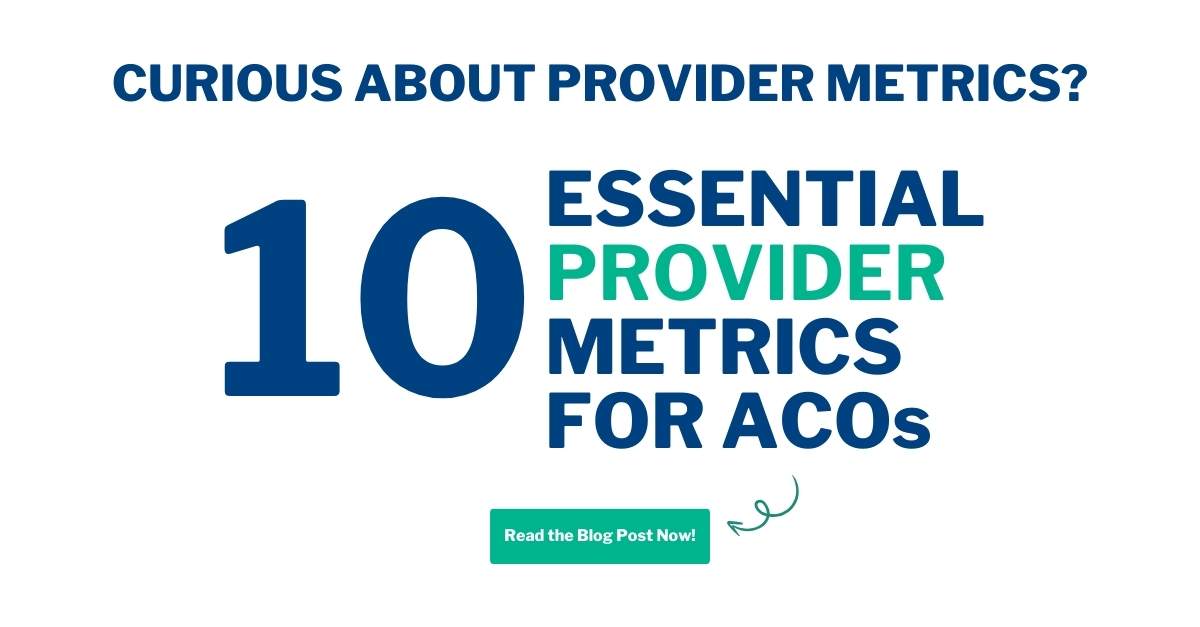Accountable Care Organizations (ACOs), are at the forefront of the value-based care movement. But to truly excel, you need more than just a commitment to quality—you need data. The right metrics can illuminate your path to improved patient outcomes and cost savings. By tracking essential patient data, you’ll gain invaluable insights into your population’s health trends, care gaps, and opportunities for intervention.
This article explores the key metrics every ACO should monitor to drive performance and achieve success. From risk stratification to utilization patterns, these data points will empower you to make informed decisions and optimize your care delivery model.
Understanding ACOs
Accountable Care Organizations (ACOs) are groups of healthcare providers who come together voluntarily to deliver coordinated, high-quality care to their patients. The primary goal of an ACO is to improve patient outcomes while reducing healthcare costs. These organizations are at the forefront of value-based care, rewarding providers for the quality of care they deliver rather than the quantity of services they provide.
Why is Patient Data Critical for ACOs?
Simply put, patient data is the lifeblood of the ACO. By leveraging comprehensive and accurate patient information, ACOs can:
- Identify high-risk patients who may benefit from preventative, proactive care strategies and interventions
- Track, predict and prepare for population health trends
- Monitor care quality and patient outcomes
- Optimize resource allocation and reduce unnecessary costs
Without robust patient data, ACOs would be flying blind, unable to effectively coordinate care or measure performance against quality benchmarks.
Harnessing Data for Improved Care Coordination
Accountable Care Organizations rely on patient data to create a holistic view of each patient’s health journey. This 360-degree perspective enables providers to make informed decisions, close care gaps, and ensure seamless transitions between different care settings. By sharing patient data across the ACO network, providers can avoid duplicate tests, reduce medical errors, and provide more personalized care plans.
The Top 10 Key Patient Data Metrics for ACOs to Track
As an accountable care organization (ACO) administrator, tracking the right patient data is crucial to improve care outcomes and reduce costs associated with your ACO. Here are the top 10 metrics you should monitor:
Clinical Outcomes
- Hospital readmission rates
- Emergency department utilization
- Chronic disease management indicators
Clinical outcome metrics help you assess the effectiveness of your care coordination efforts and identify areas for improvement. Whether it’s understanding opportunities toward reducing hospital readmissions or identifying ER Frequent Flyers, clinical outcome data helps to guide care strategy.
Patient Behavior and Adherence
- Out-of-network utilization
- Annual wellness visit and health screening progress
- Pharmacy and drug adherence
Understanding how your patients utilize services and engage with providers is essential to optimizing care quality and organizational efficiencies. Tracking the progress of your patient population to complete key screenings and exams that affect the efficacy of risk scoring sets your healthcare organization up for a higher rate of success.
Population Health
- Patient risk scoring
Accurately calculating and predicting risk scoring provides incredible insight into the overall health of your organization. Use this metric to understand future care needs, gauge the effectiveness of preventative care interventions and guide future care management strategies.
Financial Performance
- Total cost of care per patient, disease prevalence and demographic
- Shared savings or losses
- Utilization of high-cost services
Aside from maximizing care quality and effectiveness, Accountable Care Organizations must focus on financial effectiveness as well. Tracking metrics such as the total cost of care per patient, disease prevalence and demographic, as well as utilization costs helps to understand population health and care effectiveness.
By consistently monitoring these key patient data metrics, your ACO can make data-driven decisions to enhance care quality, improve patient experience and achieve more favorable financial efficiencies. The goal is not just to collect data, but to use it strategically to drive meaningful improvements in healthcare delivery and outcomes.
How to Track and Analyze Patient Data Metrics
Tracking and analyzing patient data effectively is crucial for accountable care organizations (ACOs) to meet their goals of improving outcomes and reducing costs.
Here’s how you can implement a robust healthcare analytics system:
Establish a Data Infrastructure
Creating an effective data infrastructure requires a plan. Start with understanding your data sources – create a centralized database that integrates clinical, patient and provider data across various sources, including electronic health records, claims data, and patient surveys. This foundation will enable seamless data collection and analysis across your ACO.
Define Key Performance Indicators (KPIs)
Identify the patient data metrics most relevant to your organization’s goals – both short term and long term. Ensure you have access to the aggregated data along with data sets you can drill into you.
Understand you’ll likely need additional data as your ACO progresses. Regularly review and refine these KPIs to ensure they align with your ACO’s evolving objectives. Data you’re unsure if you need now may be data you wish you had in the future.
Implement Data Analytics Tools
Utilize advanced analytics software to process and interpret your patient data. These tools can help you identify trends, predict risks, and uncover opportunities for improvement. Look for solutions that offer real-time dashboards, customizable reporting and actionable lists to keep your team informed and agile.
Measure and Iterate
Continuous improvement is key for ACOs striving to enhance care quality. Regularly track and evaluate the impact of your interventions using predetermined metrics. This might include measures like hospital readmission rates, patient satisfaction scores, or population health indicators. Use these results to refine your approach, adjusting strategies as needed to maximize positive outcomes and ensure the most effective use of resources.
Utilize patient data to create personalized care plans that address individual needs and preferences. This approach not only improves outcomes but also enhances patient engagement and satisfaction.
Foster a Data-Driven Culture
Encourage all stakeholders to embrace data-driven decision-making. Provide training on data interpretation and offer regular updates on key metrics. By making patient data accessible and actionable, you’ll empower your team to make informed choices that drive better health outcomes and operational efficiency.
Conclusion
Data is only valuable when acted upon.
By embracing data-driven patient insights, your ACO can make informed decisions that lead to better health outcomes, reduced costs, and improved quality of care. With a data-driven mindset and a commitment to continuous improvement, your ACO will be well-positioned to thrive and deliver exceptional value-based care to your patients.





